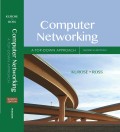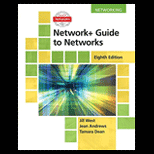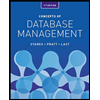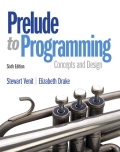
Suppose users share a 3 Mbps link. Also suppose each user requires 150 kbps when transmitting, but each user transmits only 10 percent of the time. (See the discussion of packet switching versus circuit switching in Section 1.3.)
- a. When circuit switching is used, how many users can be supported?
- b. For the remainder of this problem, suppose packet switching is used. Find the probability that a given user is transmitting.
- c. Suppose there are 120 users. Find the probability that at any given time, exactly n users are transmitting simultaneously. (Hint: Use the binomial distribution.)
- d. Find the probability that there are 21 or more users transmitting simultaneously.
Trending nowThis is a popular solution!
Learn your wayIncludes step-by-step video

Chapter 1 Solutions
EBK COMPUTER NETWORKING
Additional Engineering Textbook Solutions
Starting Out with Java: From Control Structures through Data Structures (4th Edition) (What's New in Computer Science)
Starting Out with C++: Early Objects (9th Edition)
Starting Out with Java: From Control Structures through Objects (7th Edition) (What's New in Computer Science)
Computer Science: An Overview (13th Edition) (What's New in Computer Science)
INTERNATIONAL EDITION---Engineering Mechanics: Statics, 14th edition (SI unit)
Java: An Introduction to Problem Solving and Programming (8th Edition)
- 4. Use this information to answer Question 4-8: Consider a step pn junction made of GaAs at T = 300 K. At zero bias, only 20% of the total depletion region width is in the p-side. The built-in potential o₂ = 1.20 V. Determine the acceptor density in the p-side in unit of cm³. Answers within 5% error will be considered correct. Enter answer here 5. Determine the donor density in the n-side in unit of cm³ Answers within 5% error will be considered correct. Enter answer here 6. Determine the depletion region width, z, in the n-side in unit of μm. Answers within 5% error will be considered correct. Enter answer here 7. Determine the depletion region width, xp, in the p-side in unit of μm. Answers within 5% error will be considered correct. Enter answer here 8. Determine maximum electric field in unit of V/cm. Answers within 5% error will be considered correct. Enter answer herearrow_forward1. Use this information to answer Question 1-3: Consider a step pn junction made of silicon. The p- and n-sides are doped such that Ec - EF = 0.21 eV on the n-side and EF – Ey = 0.18 eV on the p-side. The pn junction is under zero bias and kept at T = 300 K. Find the doping density in the n-side in unit of cm -3. Answers within 5% error will be considered correct. Enter answer here 2. Find the doping density in the p-side in unit of cm -3 Answers within 5% error will be considered correct. Enter answer here 3. Find the built-in potential in unit of V. Answers within 5% error will be considered correct. Enter answer herearrow_forwardMany IT implementations are operated as projects. Project stakeholders are vital aspects of the project team. Describe a project that you have worked on and the roles of each member on the team, and then answer the following questions. If you have never been on a project, find one online and answer the following questions. Why is it important to understand the role that each member plays on the team? What organization structure was in place for the project? Was the organizational structure optimal, and if so, why was it optimal? If it was not optimal, what structure would have been the optimal structure and why?arrow_forward
- This is solely for learning purposes. Please analyze the image for me. Thank youarrow_forwardthis is for educational purposes, please anylyze the image for mearrow_forwardNot: Solve this by karnof map Exclusively "Do not use Al tools. Solve the problem by hand on paper only and upload a photo of your handwritten solution."arrow_forward
- Not: Solve this by karnof map Exclusively "Do not use Al tools. Solve the problem by hand on paper only and upload a photo of your handwritten solution."arrow_forwarddt 4-12arrow_forwardFrom the following mass-spring system, obtain its transfer function and pole-zero diagram in MATLAB. Analyze how stability varies when entering values. wwwww R -0000 e(t) i(t) e(t) is the input variable, and the voltage across the capacitor is the controlled variable.arrow_forward
- Conduct a comprehensive study on Botnet networks, focusing on their architecture and functionality. Provide a detailed analysis of their control mechanisms via C2 (Command and Control) structures, and classify the different types of Botnets (centralized, decentralized, hybrid). Explain their primary uses in offensive contexts and discuss the evolution of detection and mitigation techniques in light of technological advancements in cybersecurity. Additional Note: Design a complete Botnet simulator using Python programming, including both the C2 server and the bot client. Demonstrate how the bots connect to the server, and how commands are sent and received between them.arrow_forwardI want to explain my work in Python botnets and it is completely working on the tkinter function with an explanation of how I can work on it with an introduction about what it is and what its benefit isarrow_forwardWhen you connect your device to Wi-Fi, what happens "under the hood"? Explain in detail, with pictures, what it's like.arrow_forward
 Computer Networking: A Top-Down Approach (7th Edi...Computer EngineeringISBN:9780133594140Author:James Kurose, Keith RossPublisher:PEARSON
Computer Networking: A Top-Down Approach (7th Edi...Computer EngineeringISBN:9780133594140Author:James Kurose, Keith RossPublisher:PEARSON Computer Organization and Design MIPS Edition, Fi...Computer EngineeringISBN:9780124077263Author:David A. Patterson, John L. HennessyPublisher:Elsevier Science
Computer Organization and Design MIPS Edition, Fi...Computer EngineeringISBN:9780124077263Author:David A. Patterson, John L. HennessyPublisher:Elsevier Science Network+ Guide to Networks (MindTap Course List)Computer EngineeringISBN:9781337569330Author:Jill West, Tamara Dean, Jean AndrewsPublisher:Cengage Learning
Network+ Guide to Networks (MindTap Course List)Computer EngineeringISBN:9781337569330Author:Jill West, Tamara Dean, Jean AndrewsPublisher:Cengage Learning Concepts of Database ManagementComputer EngineeringISBN:9781337093422Author:Joy L. Starks, Philip J. Pratt, Mary Z. LastPublisher:Cengage Learning
Concepts of Database ManagementComputer EngineeringISBN:9781337093422Author:Joy L. Starks, Philip J. Pratt, Mary Z. LastPublisher:Cengage Learning Prelude to ProgrammingComputer EngineeringISBN:9780133750423Author:VENIT, StewartPublisher:Pearson Education
Prelude to ProgrammingComputer EngineeringISBN:9780133750423Author:VENIT, StewartPublisher:Pearson Education Sc Business Data Communications and Networking, T...Computer EngineeringISBN:9781119368830Author:FITZGERALDPublisher:WILEY
Sc Business Data Communications and Networking, T...Computer EngineeringISBN:9781119368830Author:FITZGERALDPublisher:WILEY





